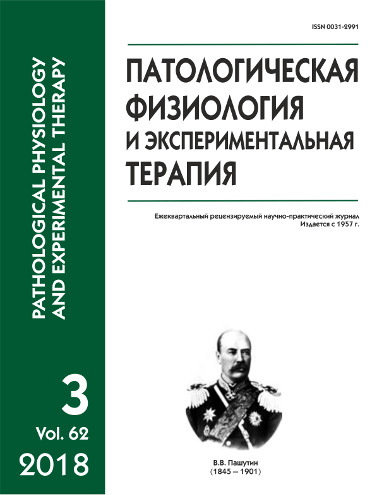Risk factors for cardiovascular diseases and development of prehypertension
DOI:
https://doi.org/10.25557/0031-2991.2018.03.37-43Keywords:
prehypertension, optimal blood pressure, risk factors for cardiovascular disease, dysregulationAbstract
The aim of the study was to investigate the relationship between risk factors for cardiovascular disease and development of prehypertension. Methods. Comparative and correlation analyses of modifiable and non-modifiable risk factors for cardiovascular disease were performed in subjects aged 30—60 with «optimal» blood pressure (n = 63, BP <120/80 mm Hg) and prehypertension (n = 52, BP = 120—139 / 80—89 mm Hg). Results. The group with prehypertension compared with the «optimal» blood pressure group had significantly increased serum levels of low-density lipoprotein (LDL) cholesterol and high-density lipoprotein (HDL) cholesterol, sedentary/intellectual type of occupation, and significant combinations of risk factors. The risk factor combinations included an increased level of LDL cholesterol and a sedentary/intellectual occupation; increased serum levels of creatinine and triglycerides; hereditary burden of kidney disease and a sedentary/intellectual occupation; hereditary burden of diabetes mellitus and cardiac left ventricular hypotrophy. In subjects with prehypertension compared to subjects with «optimal» blood pressure, changes in correlations (correlation number, direction, and strength) between parameters of risk factors were documented. Conclusion. The features of interrelationships between risk factors for cardiovascular disease observed in prehypertension are considered a manifestation of early dysregulation pathology and disordered regulation of physiological systems, which maintain optimal blood pressure.Downloads
Published
2018-10-05
Issue
Section
Original research
How to Cite
[1]
2018. Risk factors for cardiovascular diseases and development of prehypertension. Patologicheskaya Fiziologiya i Eksperimental’naya Terapiya (Pathological physiology and experimental therapy). 62, 3 (Oct. 2018), 37–43. DOI:https://doi.org/10.25557/0031-2991.2018.03.37-43.






